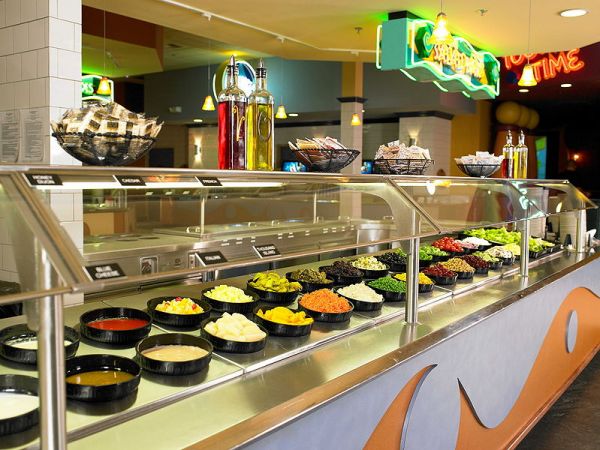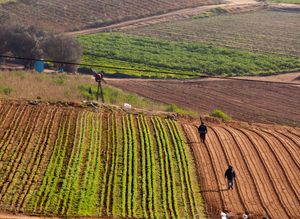, a twice-weekly newsletter that hunts for the end of the long tail. In another life, he ran
.
The
salad bar is something that many restauranteurs claim to have
invented, but we know for sure that just one guy invented the sneeze
guard.
In January, a major lobbying group for the school
lunch industry won a victory that involved salad bars. The School
Nutrition Association, feeling the pressure because of what it called
arduous nutrition rules,
fought for (and won) a slightly more reasonable policy,
including rules that specifically allowed schools to continue to offer
salad bars to those super-grubby, messy kids. Some local health
inspectors tried to veto the salad bars, claiming they created health
hazards. But the updated law Congress came up with clarified that salad
bars are safe. Today’s issue ponders why salad bars have become so
common and whether the scale is trying to rip us off.
Salad Bar Origins
“You know, I looked at what was the problem with
restaurants. You’d go in, the waiter would come up to the table, maybe
he wouldn’t, and then he’d take an order, and disappear for a while.
You’d fill up on bread. I said I want to let the customer see what he’s
getting. And that includes a salad.”
— Norman Brinker, a groundbreaking restauranteur during the 1960s and 1970s, discussing
his claimed invention of the salad bar concept
for his Steak & Ale restaurant chain. Whether he did or not is a
point of dispute, but he most certainly had the most success with it.
(He also played a key role in the expansion of two other chains that
you’re probably more familiar with, Chili’s and Bennigan’s.) Brinker,
who
gained status as a business guru
before his death, was a master at building a more casual approach to
dining—hiring cheery college students instead of snooty waiters and
creating a vibe that encouraged repeat visits. And to think, it all
started with the salad bar.

Five other key points in salad bar history
In the 1950s, a restaurant called The Cliffs
in Springfield, Illinois made its claim to being the originators of
the “famous salad bar.” This postcard in the Illinois Digital Archive
also makes the case. The Cliffs (which had air conditioning!) came around nearly two decades before Steak & Ale.
Chuck’s Steak House in Waikiki, first founded in 1959 is
another of the claimants of having the first salad bar. The chain is still around today, somehow.
In 1971,
the Chicago-based restaurant R.J. Grunts launched with a massive salad
bar, complete with 40 different items. The restaurant, which
ultimately begat a conglomerate
called Lettuce Entertain You, was a key part of the salad bar becoming a trend in the 1970s.
The decision by Wendy’s to go
all-in on salad bars in 1979 started a trend of salad bars at fast-food outlets, and Wendy’s was out front for much of that period—at one point
extending the concept to a Superbar buffet. But Wendy’s eventually pulled out of the concept entirely in 2006—long after its competitors did the same.
In the early 1990s,
the salad bar concept began to evolve in big cities, so that many
smaller restaurants began to try it on for size. This is around the
time that the salad bar concept moved away from all-you-can-eat to the
scale-based format, which is also used in grocery stores. “Salad bars
have become the cafeterias of the 90′s—cheap, convenient and with
something for everyone,”
The New York Times wrote about them in 1994.
Pay by the pound: How Whole Foods ruined a good thing
It’s arguable that the biggest problem
Whole Foods has with the public is its scales. Its hot and cold salad
bars, which would likely be considered a buffet if it didn’t charge by
the ounce, probably do more than anything else to give the chain its
reputation as “Whole Paycheck.”
Last year, the company found itself
the target of some embarrassing headlines in New York City,
which were caused in part due to “scales not being calibrated
correctly.” The company responded with a blog post and video titled ”
Addressing Weight and Pricing: A Message to Our Customers,”
which featured two contrite-looking co-CEOs. It’s long been a big
problem for the grocer, but it’s been much more of one for consumers,
who end up paying extra cash for those rubber-band-wrapped boxes.
(The company
eventually settled with the city for $500,000, which is bad, but not nearly as bad as
the $800,000 Whole Foods paid out the year before over similar claims in California.)
But let’s assume the scales
are
calibrated correctly. The food’s pretty good, but there’s sure a lot
of couscous, and heavy dressing in the mix. And at the hot bar, they
sure are nudging you toward the mashed potatoes, the mac and cheese,
and the red beans and rice, aren’t they?
That’s no accident, of
course. Those salad bars are designed to be immensely profitable for
Whole Foods, which most assuredly does not pay $8.99 per pound for all
those ingredients.
Salad bars have in recent years become more
aggressive at charging by weight, and they put out ingredients that are
specifically designed to add weight, like croutons and dressings.
(Many salad-bar strategy guides specifically recommend you buy the
heavy ingredients separately and add them to your salad after the
fact.)
But Whole Foods has taken this maximize-weight approach to a
different level by putting particularly heavy things out there as
options. The fried chicken and casserole prey on your worst nourishment
tendencies, those moments of impulse that you would otherwise avoid at
all costs. And for those who want to eat something more exotic—ooh,
johnnycakes!—they have you covered, too.
They’re tricking you into
getting more than you actually want, and by the time you’ve realized
you’ve put $20 of stuff into a biodegradable bowl, it’s too late. It’s
not like you’re gonna put that gravy-covered lump of mashed potato
back, are you?
Whole Foods knows that this strategy is brilliant and effective, but it can in fact be defeated. In a 2011
New York Times Magazine piece,
statistical genius Nate Silver recommended
that people buy goods at the salad bar that cost as much or more
elsewhere in the store. Instead of romaine lettuce, get in on the
mesclun; get some blue cheese instead of the ranch; and get loads of
exotic toppings, which often cost as much or more in the store than the
salad you’re getting.
The scales may not be calibrated properly, but there’s still room for you to tip them in your favor.
The Sneeze Guard
“Being the germaphobe that he was, he couldn’t stand
people going down the Smorgasbords smelling things and having their
noses too close to the food. He said to his engineers, ‘We have to
devise something—I don’t want these people sneezing on the food.’”
— Barbara Kelley, the daughter of sneeze guard inventor Johnny Garneau,
discussing the importance of the invention.
The plate of glass separating your bacteria from the food that’s just
sitting out came about out of a desire for Garneau to innovate at his
Pennsylvania smorgasbord business. His timing was opportune—just a few
years after filing for a patent on the
sneeze guard, the federal government took steps to require that every salad bar had one.
Is It Worth It?
So going back to the start of the piece,
it’s worth asking—did those health inspectors who tried to put the
kibosh on the school salad bars have a point? Even with the sneeze
guards?
Last year, a South Carolina television station
worked with a laboratory to test how safe a selection of salad bar food
was. They overnighted the ingredients—a mix of raw and prepared
food—to a Seattle-area lab, which did a variety of tests on the final
result.
They found that while the food did not test positive for
any of the tell signs of food poisoning—E. coli, listeria and
salmonella—but much of the raw food did show signs of large numbers of
microbes and coliform, some above the level of what was considered
safe. But at the same time, IEH Laboratories CEO Dr. Mansour Samadpour
tried to make clear that food isn’t meant to be sterile, and that
coliform levels
can seem unnaturally high.
Still, though, it’s a reminder that sneeze guards can only do so much.









































